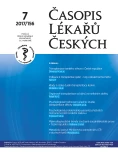Indications to liver transplantation
Authors:
Pavel Taimr
Authors place of work:
Klinika hepatogastroenterologie IKEM, Praha
Published in the journal:
Čas. Lék. čes. 2017; 156: 355-360
Category:
Přehledové články
Summary
Liver transplantation should be considered in patients with end-stage liver disease in whom this operation would extend life expectancy beyond what the natural history of underlying disease would predict or in whom transplantation is likely to substantially improve the quality of life.
Liver transplantation is indicated in end-stage liver disease, in selected liver tumors and in fulminant liver failure. The most common indication in adult to transplantation is decompensated liver cirrhosis with life expectancy one year or less. Evaluation and referral to transplantation center should be considered when a major complication of liver cirrhosis occurs – ascites, bleeding due to portal hypertension, hepatorenal syndrome or hepatic encephalopathy. MELD score ≥ 15 is recommended to list patients with end-stage liver disease.
In recent years the indication of decompensated cirrhosis B and C is declining, on contrary, there is an increase in indication for hepatocellular carcinoma and NASH. An extension of indications has been observed recently – patients above 70 years of age, patients with neuroendocrine tumors among others.
In 2016 in Czech Republic total 179 livers were transplanted, but only a small fraction of potential candidates was referred to transplant centers.
Keywords:
liver transplantation, liver cirrhosis, hepatocellular carcinoma, fulminant liver failure
Zdroje
1. Trunečka P, Gerlei Z, Lisik W et al. Liver transplantation in Central Europe. Clin Exp Hepatol 2016; 2: 21–26.
2. Ryska M, Trunečka P. Transplantace jater – současný stav ve světě a u nás. Časopis lékařů českých 2003; 12: 717–726.
3. European Association for the Study of the Liver. EASL Clinical Practice Guidelines: Liver transplantation. J Hepatol 2016; 64: 433–485.
4. Martin P, DiMartini A, Feng S et al. Evaluation for liver transplantation in adults: 2013 practice guideline by the American Association for the Study of Liver Disease and American Society for Transplantation. Hepatology 2014; 59(3): 1144–1165.
5. Kieslichová E, Ročeň M, Fraňková S, Trunečka P. Akutní selhání jater – současná doporučení. Časopis lékařů českých 2011; 150: 24–30.
6. Dutkowski P, Linecker M, DeOliveira ML et al. Challenges to liver transplantation and strategies to improve outcomes. Gastroenterology 2015; 148: 307–323.
7. Wiesner R, Edwards E, Freeman R et al. Model for end-stage liver disease (MELD) and allocation of donor livers. Gastroenterology 2003; 124: 91–96.
8. Malinchoc M, Kamath PS, Gordon FD et al. A model to predict poor survival in patients undergoing transjugular intrahepatic portosystemic shunts. Hepatology 2000; 31: 864–871.
9. Merion RM, Schaubel DE, Dykstra DM et al. The survival benefit of liver transplantation. Am J Transplant 2005; 5: 307–313.
10. Pfitzmann R, Schwenzer J, Rayes N et al. Long-term survival and predictors of relapse after ortotopic liver transplantation for alcoholic liver disease. Liver Transpl 2007; 13: 197–205.
11. Mathurin P, Moreno C, Samuel D et al. Early liver transplantation for severe alcoholic hepatitis. N Engl J Med 2011; 365: 1790–1800.
12. Charlton M. Evolving aspects of liver transplantation for nonalcoholic steatohepatitis. Curr Opin Organ Transplant 2013; 18: 251–258.
13. Dare AJ, Plank LD, Philips AR et al. Addictive effect of pretransplant obesity, diabetes, and cardiovascular risk factors on outcomes after liver transplantation. Liver Transpl 2014; 20; 281–290.
14. Boberg KM, Lind GE. Primary sclerosing cholangitis and malignancy. Best Pract Res Clin Gastroenterol 2011; 25: 753–764.
15. Mazzaferro V, Regalia E, Doci R et al. Liver transplantation for the treatment of small hepatocellular carcinomas in patients with cirrhosis. N Engl J Med 1996; 334: 694–699.
16. Clavien PA, Lesurtel M, Bossuyt PM et al. Recommendations for liver transplantation for hepatocellular carcinoma: an international consensus conference report. Lancet Oncol 2012; 13; e11–e22.
17. Mergental H, Porte RJ. Liver transplantation for unresectable hepatocellular carcinoma in patients without liver cirrhosis. Transpl Int 2010; 23: 662–667.
18. Lerut JP, Orlando G, Adam R et al. The place of liver transplantation in the treatment of hepatic epitheloid hemangioendothelioma: report of the European liver transplant registry. Ann Surg 2007; 246: 949–957.
19. Hagness M, Foss A, Line PD et al. Liver transplantation for nonresectable liver metastases from colorectal cancer. Ann Surg 2013; 257: 800–806.
20. Koch DG, Fallon MB. Hepatopulmonary syndrome. Curr Opin Gastroenterol 2014; 30: 260–264.
21. Durand F, Buyse S, Francoz C et al. Prognostic value of muscle atrophy in cirrhosis using psoas muscle thickness on computed tomography. J Hepatol 2014; 60: 1151–1157.
22. Janoušek L, Adamec M, Oliverius M et al. Transplantace jater s trombózou v. portae. Časopis lékařů českých 2011; 150: 72–74.
Štítky
Adiktologie Alergologie a imunologie Angiologie Audiologie a foniatrie Biochemie Dermatologie Dětská gastroenterologie Dětská chirurgie Dětská kardiologie Dětská neurologie Dětská otorinolaryngologie Dětská psychiatrie Dětská revmatologie Diabetologie Farmacie Chirurgie cévní Algeziologie Dentální hygienistkaČlánek vyšel v časopise
Časopis lékařů českých

- Přerušovaný půst může mít významná zdravotní rizika
- Top zaměstnavatelé ve zdravotnictví si hýčkají už studenty
- Mikroplasty a jejich riziko pro zdraví: Co všechno víme?
- Ukažte mi, jak kašlete, a já vám řeknu, co vám je
- Metamizol jako analgetikum první volby: kdy, pro koho, jak a proč?
Nejčtenější v tomto čísle
- Indikace k transplantaci jater – kdy odeslat nemocného
- Transplantace tenkého střeva v České republice
- Orgánové transplantace od dárců se selháním oběhu
- Psychologická problematika pacientů přeživších mimonemocniční srdeční zástavu
